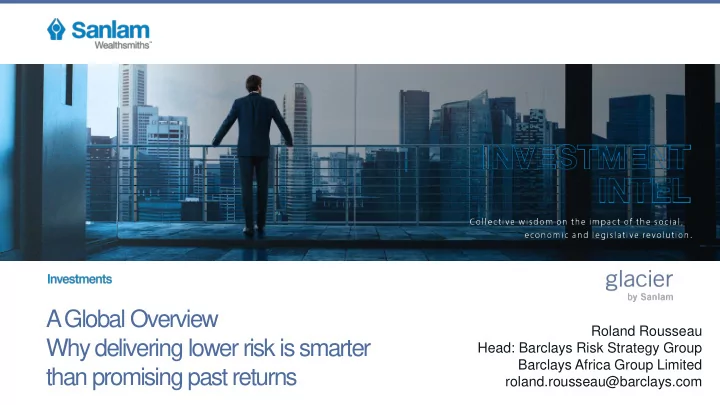

A Global Overview Roland Rousseau Why delivering lower risk is smarter Head: Barclays Risk Strategy Group Barclays Africa Group Limited than promising past returns roland.rousseau@barclays.com
Why delivering lower risk is smarter than promising past returns 1. Why skill is never enough! 2. Why neither active nor passive investing can save us 3. The strange future of asset management
Why skill is never enough!
What do investors really , really need? • ‘Excess’ return (e.g. above inflation, benchmark, liabilities etc.) • Excess Return Positive return after all costs • Return without excessive ‘risk’ Perceived Key question: Value How necessary is skill? Tolerable Risk Acceptable Costs
How important is skill (beating benchmarks)? 1,200 1,200 1,100 1,100 FTSE/JSE Div+ Index 1,000 1,000 (JSE: code: STXDIV) 900 900 Manager ‘M’ (top -quartile) 800 800 FTSE/JSE Top-40 Index 700 700 600 600 500 500 400 Does this manager 400 300 300 possess real skill? 200 200 Would you 100 100 recommend a top- - - decile index fund? 2002 2004 2006 2008 2010 2012 2014 2002 2004 2006 2008 2010 2012 2014
How important is skill (beating benchmarks)? 900 800 60% Equity + 40% Bonds 700 600 CPI+6% 500 CPI+4% 400 300 CPI 200 100 0 1999 2000 2001 2002 2003 2004 2005 2006 2007 2008 2009 2010 2011 2012 2013 2014
Never confuse excess return with skill Risk-Factor eg currency, interest rates 5% 0% Risk-Premium eg equity, value, momentum, EM etc • Why do we invest in equities? • Risk premia are not a free lunch! • Excess returns exist regardless of skill
Never confuse excess return with skill How can we beat these benchmarks without skill? Benchmark Benchmark Benchmark Return: Return: Return: JSE ALSI, FTSE 50% Equity + MSCI World 100, S&P500 50% Bonds Index Chasing past performance doesn’t work, because we inevitably chase higher risk, rather than true skill.
Risk matching – a big step in the right direction Manager A 100% Equity Return 15% Manager return has to be judged in comparison 10% Investor to level of portfolio risk opportunity 100% Bonds Proper risk-adjusted performance (Jensen 5% a ) is global standard but 100% Cash Risk (eg volatility) not in SA! 5% 10% 15%
10 Is skill attributable to ‘excess risk’? Maybe what we’re calling skill really isn’t skill. It may turn out that skill can be partially decomposed into what have come to be called the Fama/French risk factors – the small-cap premium, the value-growth spread, the momentum effect, etc. Discussion may turn to how the excess returns, now attributed to skill, are actually coming from such factors. Harindra de Silva CFA Magazine Journal (Sept-Oct 2006)
Why neither active nor passive investing can save us
Problem with active and passive management Option 1: Active Management Option 2: Passive Management Manager Unstable Unstable Selection Risk Exposure Risk Exposure Manager F Passive Passive Manager I Value Market Market Index Mom (eg SWIX) Manager C Manager A Neither active nor passive investing are properly diversified
Active managers are poorly diversified ADJ. R 2 FUND RISK FACTORS MARKET BETA ALPHA PORTFOLIO Rand Hedge; Low Beta 93.20% 0.87*** 0.001 M1 Rand Hedge; Low Beta 88.75% 0.90*** 0.002* M2 Rand Hedge; Low Beta 89.43% 0.87*** 0.003** M3 Rand Hedge; Value 88.77% 0.81*** 0.002* M4 Rand Hedge; Value 90.53% 0.89*** 0.001 M5 Rand Hedge; Low Beta 90.63% 0.90*** -0.0003 M6 Rand Hedge; Low Beta 80.97% 0.74*** 0.004*** Source: Department of Finance – WITS
Market indices are also poorly diversified The market index is incredibly undiversified
Stocks’ risk contributions The market’s risk NPN contributions are even more concentrated MTN SOL AGL
How to improve risk structure of the market 600 Optimised Find the weights for Top 40 500 Top 40 stocks with ‘maximum diversification’ 400 Step 1: ensure 300 ‘good’ risks ( ie risk Top 40 premia) are always 200 present 100 Step 2: minimise concentration 0 2007 2008 2009 2010 2011 2012 2013 2014 2015
The strange future of asset management
Four forces disrupting investment management Force 1: Benchmarking revolution Why excess returns tell us nothing about skill. We need proper-risk adjusted returns Force 2: Index revolution Why hiring and firing indices is smarter to manage risk than hiring and firing managers Force 3: Portfolio-construction revolution Only modular portfolios can adapt to changing market conditions quickly and efficiently Force 4 : Risk management revolution Promising past returns does not work but we can lower risk and the cost of investing
Conclusion: We need to improve active and passive investments Passive Funds need more Active Funds need more than than just ‘Momentum’ risk just ‘Value’ risk exposure exposure Active Funds must reduce Passive Funds must reduce their high correlation to the their extreme stock market concentration • Challenge: Neither active/passive funds are able to adapt to changing market conditions efficiently (eg high vs low volatility regimes)
The future is here .
Thank you
Recommend
More recommend